The Impact of the Secular Trend of the Slovak Population on the Production of Wooden Beds and Seating Furniture
Abstract
1. Introduction
2. Experimental Design
3. Results
4. Discussion
5. Conclusions
Author Contributions
Funding
Institutional Review Board Statement
Informed Consent Statement
Data Availability Statement
Conflicts of Interest
References
- Tunay, M.; Melemez, K. An analysis of biomechanical and anthropometric parameters on classroom furniture design. Afr. J. Biotechnol. 2008, 7, 1081–1086. [Google Scholar]
- Kubašáková, I.; Kampf, R.; Stopka, O. Logistics information and communication technology. Komunikacie 2014, 16, 9–13. [Google Scholar]
- Tokarcikova, E.; Kucharcikova, A.; Janosova, P. The Relationship between Environmental and Economic Aspects for Measuring the Sustainability of the Enterprise: A Case Study of Slovak Manufacturing Enterprises. Int. J. Environ. Res. Public Health 2022, 19, 7784. [Google Scholar] [CrossRef] [PubMed]
- Ramos, D.; Cotrim, T.; Arezes, P.; Baptista, J.; Rodrigues, M.; Leitão, J. Frontiers in Occupational Health and Safety Management. Int. J. Environ. Res. Public Health 2022, 19, 10759. [Google Scholar] [CrossRef] [PubMed]
- Strelka, F. Methodology for measurement of basic anthropometric parameters. Acta Hyg. Epid. Microbiol. 1978, 11, 73027. [Google Scholar]
- Zellner, K.; Jaeger, U.; Kromeyer Hauschild, K. Height, weight and BMI of schoolchildren in Jena, Germany—are the secular changes levelling off? Econ. Hum. Biol. 2004, 2, 281–294. [Google Scholar] [CrossRef]
- Widyanti, A.; Susanti, L.; Sutalaksana, Z.; Muslim, K. Ethnic differences in Indonesian anthropometry data: Evidence from three different largest ethnics. Int. J. Ind. Ergon. 2015, 47, 72–78. [Google Scholar] [CrossRef]
- Havari, E.; Peracchi, F. Growing up in wartime: Evidence from the era of two world wars. Econ. Hum. Biol. 2017, 25, 9–32. [Google Scholar] [CrossRef]
- Tanner, J.M. Growth as a measure of the nutritional and hygienic status of a population. Horm. Res. 1995, 38, 106–115. [Google Scholar] [CrossRef]
- Wongwien, T.; Nanthavanij, S. Multi-objective ergonomic workforce scheduling under complex worker and task constraints. Int. J. Ind. Eng. Theory 2017, 24, 284–294. [Google Scholar]
- Raghav, G.; Farooq, M.; Khan, A.A.; Muzammil, M. Ergonomic modification and Evaluation of the Chain Saw handle in wood cutting. Can. Acoust. 2011, 39, 90–91. [Google Scholar]
- Koman, G.; Tumova, D.; Jankal, R.; Miciak, M. Business-Making Supported Via the Application of Big Data to Achieve Economic Sustainability. Entrep. Sustain. Issues 2022, 9, 336–358. [Google Scholar] [CrossRef]
- Vilkovska, T.; Klement, I.; Vybohova, E. The Effect of Tension Wood on the selected physical properties and chemical composition of beech wood (Fagus sylvatica L.). Acta Fac. Xylologiae Zvolen 2018, 60, 31–40. [Google Scholar] [CrossRef]
- Gergeľ, T.; Bucha, T.; Gracovský, R.; Chamula, M.; Gejdoš, M.; Veverka, P. Computed Tomography as a Tool for Quantification and Classification of Roundwood—Case Study. Forests 2022, 13, 1042. [Google Scholar] [CrossRef]
- Gejdoš, M.; Suchomel, J.; Danihelová, Z. Analysis of Qualitative Features of Beech and Oak Trunks as a Determinant of the Quality Assessment. Forests 2021, 12, 15. [Google Scholar] [CrossRef]
- Chen, B.; Xia, H.; Hu, W. The design and evaluation of three-dimensional corner joints used in wooden furniture frames: Experimental and numerical. BioResources 2022, 17, 2143–2156. [Google Scholar] [CrossRef]
- Kayis, B.; Ozok, A.F. The anthropometry of Turkish army men. Appl. Ergon. 1991, 22, 49–54. [Google Scholar] [CrossRef]
- Loesch, D.Z.; Stokes, K.; Huggins, P.M. Secular trend in height and weight of Australian children and adolescents. Am. J. Phys. Anthropol. 2000, 111, 545–556. [Google Scholar] [CrossRef]
- Cole, T.J. Secular trends in growth. Proc. Nutr. Soc. 2000, 59, 317–324. [Google Scholar] [CrossRef] [PubMed]
- Bolstad, G.; Benum, B.; Rokne, A. Anthropometry of Norwegian light industry and office workers. Appl. Ergon. 2001, 32, 239–246. [Google Scholar] [CrossRef]
- Mokdad, M. Anthropometric study of Algerian farmers. Int. J. Ind. Ergonom. 2002, 29, 331–341. [Google Scholar] [CrossRef]
- Jelačić, D.; Greger, K.; Grladinović, T. Research on anthropometric characteristics of high school students and ergonomic characteristics of high school furniture. Drvna Ind. 2002, 53, 99–106. [Google Scholar]
- Barroso, M.P.; Arezes, P.M.; Costa, L.G.; Miguel, A.S. Anthropometric study of Portuguese workers. Int. J. Ind. Ergonom. 2005, 35, 401–410. [Google Scholar] [CrossRef]
- Vignerová, J.; Brabec, M.; Bláha, P. Two centuries of growth among Czech children and youth. Econ. Hum. Biol. 2006, 4, 237–252. [Google Scholar] [CrossRef] [PubMed]
- Chuan, T.K.; Hartono, M.; Kumar, N. Anthropometry of the Singaporean and Indonesian populations. Int. J. Ind. Ergonom. 2010, 40, 757–766. [Google Scholar] [CrossRef]
- Kubenka, M.; Myskova, R. Obvious and Hidden Features of Corporate Default in Bankruptcy Models. J. Bus. Econ. Manag. 2019, 20(2), 368–383. [Google Scholar] [CrossRef]
- Jirkovský, D. Body height and weight in young men aged 18–25 in the second half of the 20th century. Vojenské Zdr. Listy 2003, 72, 217–230. [Google Scholar]
- Cole, T.J. The secular trend in human physical growth: A biological view. Econ. Hum. Biol. 2003, 1, 161–168. [Google Scholar] [CrossRef]
- Skrotzki, R. Hardware-Ergonomie; Institut für Arbeitswissenschaft, Ruhr-Universität: Bochum, Germany, 2011; Available online: https://www.imtm-iaw.ruhr-uni-bochum.de/wp-content/uploads/sites/5/2011/08/hardware_ergonomie2011.pdf (accessed on 16 September 2022).
- Brunecký, P. Technické předpisy a problematika soudního znalectví nábytku. [Technical regulations and issues of judicial furniture expertise]. In Proceedings of the International scientific conference Interiér 2009, Bratislava, Slovakia, 24–25 September 2009; Slovak University of Technology: Bratislava, Slovakia, 2009; pp. 22–24. [Google Scholar]
- Galton, F. Anthropometric percentiles. Nature 1885, 31, 223–225. [Google Scholar] [CrossRef]
- Baffoe-Djan, J.B.; Smith, S.A. Descriptive statistics in data analysis. In Routledge Handbook of Research Methods in Applied Linguistics, 1st ed.; McKinley, J., Rose, H., Eds.; Routledge: Oxford, UK, 2020; pp. 398–414. [Google Scholar]
- Patten, M.L.; Newhart, M. Descriptive and inferential statistics. In Understanding Research Methods: An Overview of the Essentials, 10th ed.; Patten, M.L., Newhart, M., Eds.; Routledge: Oxford, UK, 2018; pp. 203–206. [Google Scholar]
- Young, J.; Wessnitzer, J. Descriptive statistics, graphs, and visualisation. In Modern Statistical Methods for HCI, 1st ed.; Robertson, J., Kaptein, M., Eds.; Springer: Dordrecht, The Netherlands, 2016; pp. 37–56. [Google Scholar] [CrossRef]
- Kanická, L.; Holouš, Z. Nábytek, Typologie, Základy Tvorby. [Furniture: Typology, Basics of Creation], 1st ed.; Grada Publishing: Praha, Czech Republic, 2011; p. 160. [Google Scholar]
- Komlos, J.; Lauderdale, B.E. The mysterious trend in American heights in the 20th century. Ann. Hum. Biol. 2007, 34, 206–215. [Google Scholar] [CrossRef]
- Leitao, R.B.; Rodrigues, L.P.; Neves, L.; Carvalho, G.S. Development of adiposity, obesity and age at menarche: An 8-year follow-up study in Portuguese schoolgirls. Int. J. Adolesc. Med. Health 2013, 25, 55–63. [Google Scholar] [CrossRef] [PubMed]
- Fudvoye, J.; Parent, A.S. Secular trends in growth. Klotz Communications 2017: From the shortest to the tallest. Ann. D’endocrinol. 2017, 78, 88–91. [Google Scholar]
- Gomula, A.; Nowak-Szczepanska, N.; Danel, D.P.; Koziel, S. Overweight trends among Polish schoolchildren before and after the transition from communism to capitalism. Econ. Hum. Biol. 2015, 19, 246–257. [Google Scholar] [CrossRef]
- Smpokos, E.A.; Linardakis, M.; Padadaki, A.; Kafatos, A. Secular changes in anthropometric measurements and blood pressure in children of Crete, Greece, during 1992/1993 and 2006/2007. Orev. Med. 2011, 52, 213–217. [Google Scholar]
- Bielecki, E.M.; Haas, J.D.; Hulanicka, B. Secular changes in the height of Polish schoolboys from 1955 to 1988. Econ. Hum. Biol. 2012, 10, 310–317. [Google Scholar] [CrossRef] [PubMed]
- Thompson, J.L. Obesity and consequent health risks: Is prevention realistic and achievable? Arch. Dis. Child. 2008, 93, 722–724. [Google Scholar] [CrossRef]
- Kovařík, M. Antropometrický Výzkum Dospělé Populace a Jeho Aplikace v Oblasti Interiéru a Architektury [Anthropometric Research of the Adult Population and Its Application in the Field of Interior Design and Architecture], 1st ed.; VUT Brno: Brno, Czech Republic, 2011; p. 78. [Google Scholar]
- Ližbetin, J. Decision-making Processes in Introducing RFID Technology in Manufacturing Company. Nase More 2018, 65, 289–292. [Google Scholar] [CrossRef]
- Stopka, O.; Luptak, V. Optimization of Warehouse Management in the Specific Assembly and Distribution Company: A Case Study. Nase More 2018, 65, 266–269. [Google Scholar] [CrossRef]
- Kasal, A.; Smardzewski, J.; Kuskun, T.; Erdil, Y.Z. Numerical Analyses of Various Sizes of Mortise and Tenon Furniture Joints. BioResources 2016, 11, 6836–6853. [Google Scholar]
- Hu, W.; Wan, H.; Guan, H. Size Effect on the Elastic Mechanical Properties of Beech and Its Application in Finite Element Analysis of Wood Structures. Forests 2019, 10, 783. [Google Scholar] [CrossRef]
- Kamenický, J. K problematike poddajnosti a namáhania spojov stoličiek [To the problem of flexibility and stress of chair joints]. Drevo 1978, 33, 291–294. [Google Scholar]
- Eckelman, C.A. Textbook of Product Engineering and Strength Design of Furniture, 1st ed.; Purdue University: West Lafayette, IN, USA, 2003; p. 205. [Google Scholar]
- Smardzewski, J. Numerical analysis of furniture constructions. Wood Sci. Technol. 1998, 32, 273–286. [Google Scholar] [CrossRef]
- Smardzewski, J.; Prekrat, S. Stress distribution in disconnected furniture joints. Electron. J. Pol. Agricul. Univ. Wood Technol. 2002, 5, 4. [Google Scholar]
- Pousette, A. Full-scale test and finite element analysis of a wooden spiral staircase. Holz Roh Werkst. 2003, 61, 1–7. [Google Scholar] [CrossRef]
- Horman, I.; Martinovič, D.; Hajdarevič, S. Finite Volume Method for Analysis of Stress and Strain in Wood. Drvna Ind. 2009, 60, 27–32. [Google Scholar]
- Horman, I.; Hajdarevič, S.; Martinovič, S.; Vukas, N. Numerical Analysis of Stress and Strain in a Wooden Chair. Drvna Ind. 2010, 61, 151–158. [Google Scholar]
- Cameron, N. Human Growth and Development, 2nd ed.; Academic Press: Leicestershire, UK, 2002; p. 600. [Google Scholar]
- Chen, S.; Guo, X.; Yu, S.; Zhou, Y.; Li, Z.; Sun, Y. Anthropometric indices in adults: Which is the best indicator to identify alanine aminotransferase levels? Int. J. Environ. Res. Public Health 2016, 13, 226. [Google Scholar] [CrossRef]
- Potkány, M.; Htka, M.; Krajčírová, L.; Štarchoň, P. Use of Variators in Applying the Cost Calculation Methodology in Small and Medium Furniture Enterprises Based on Changes in Human Body Dimensions. Drvna Ind. 2019, 70, 27–35. [Google Scholar] [CrossRef]
- Hua, L.S.; Chen, L.W.; Antov, P.; Kristak, L.; Tahir, P.M. Engineering Wood Products from Eucalyptus spp. Adv. Mater. Sci. Eng. 2022, 2022, 8000780. [Google Scholar] [CrossRef]
- Branowski, B.; Zablocki, M.; Kurczewski, P.; Sydor, M. A Method for Modeling the Individual Convenient Zone of a Human. Int. J. Environ. Res. Public Health 2022, 19, 10405. [Google Scholar] [CrossRef]
- Neykov, N.; Antov, P.; Savov, V. Circular Economy Opportunities for Economic Efficiency Improvement in Wood-based Panel Industry. In Proceedings of the 11th International Scientific Conference “Business and Management 2020”, Vilnius, Lithuania, 7–8 May 2020; Vilnius Gediminas Technical University: Vilnius, Lithuania, 2020. 10p. [Google Scholar] [CrossRef]


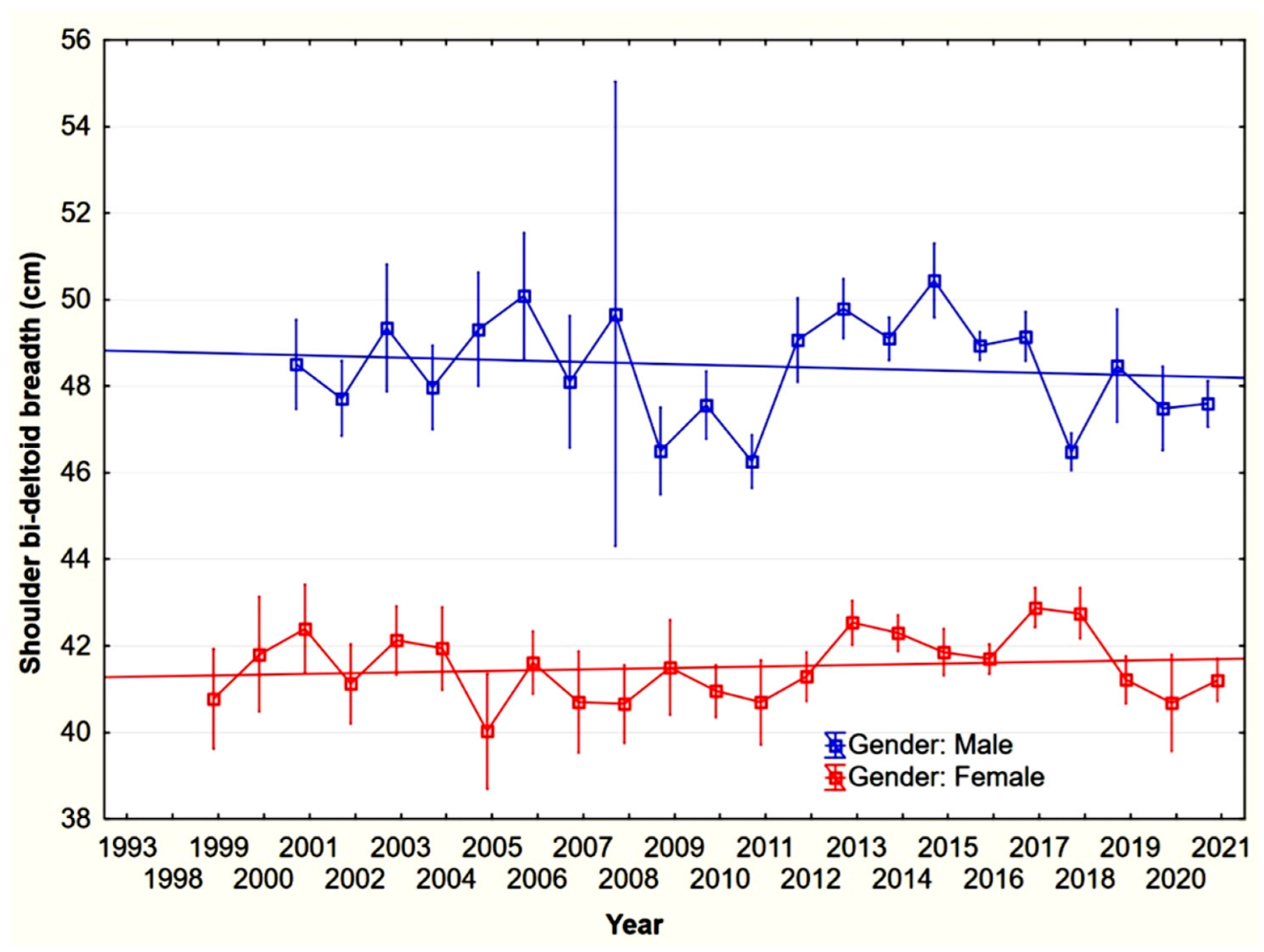
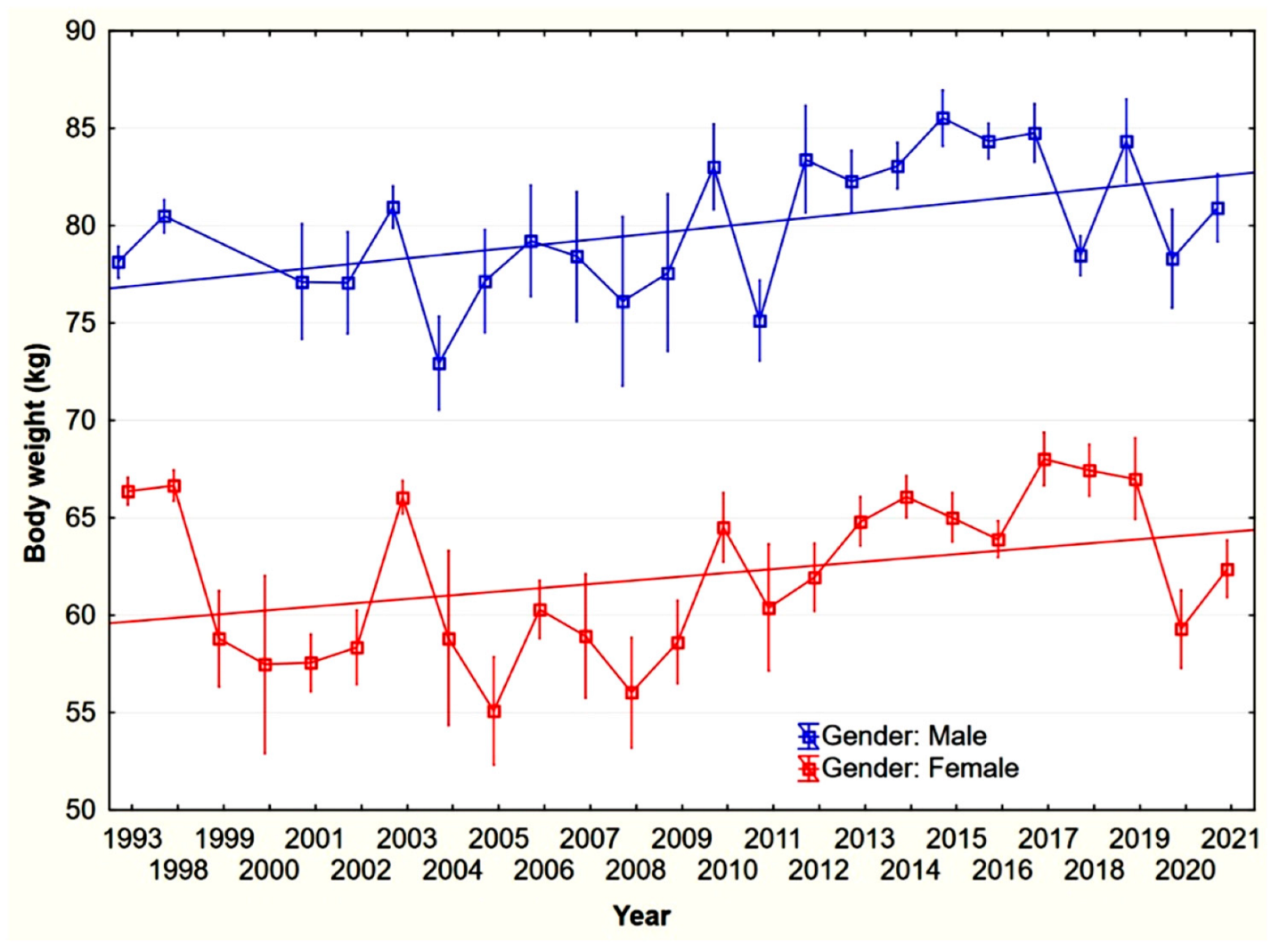
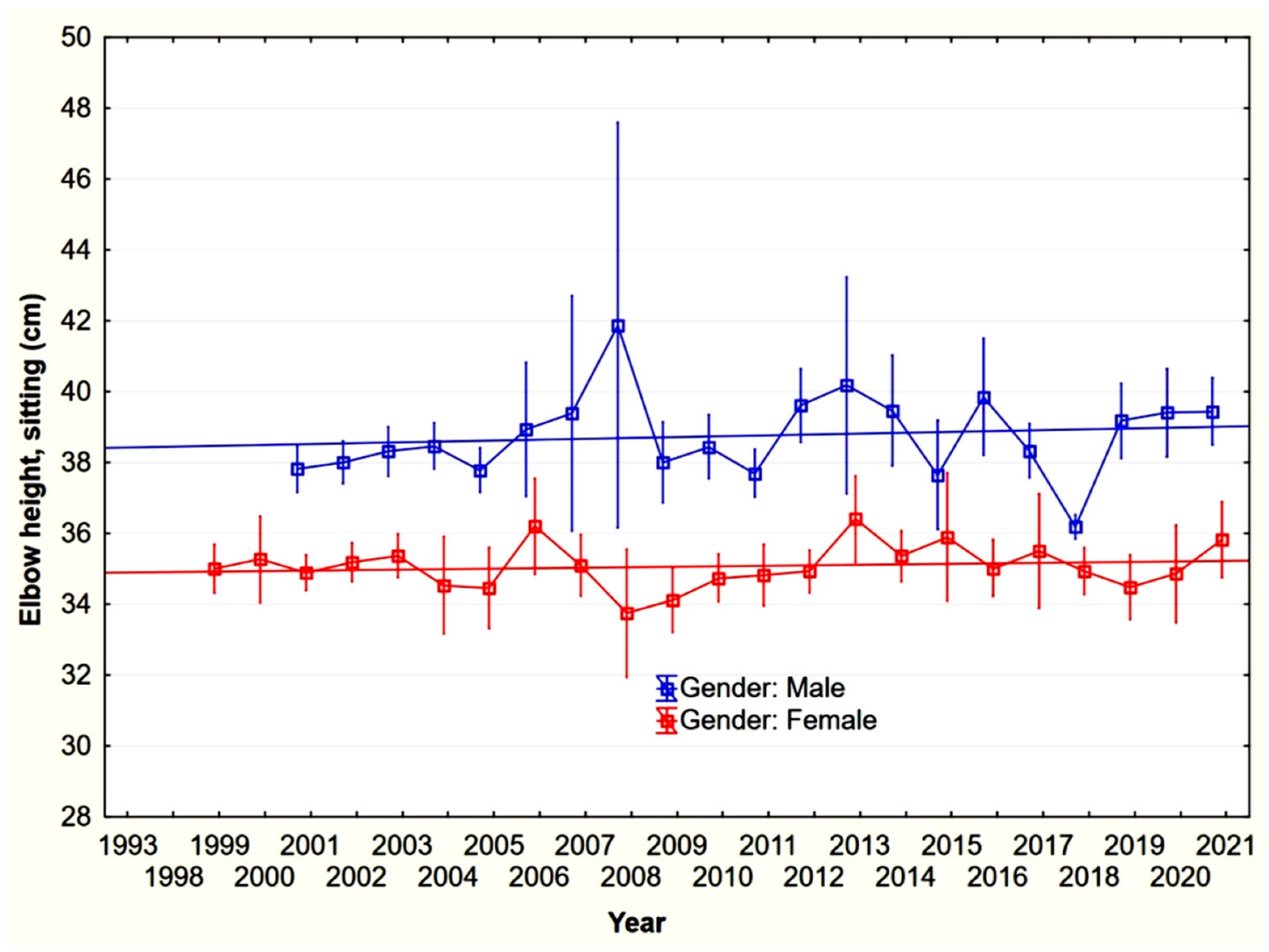


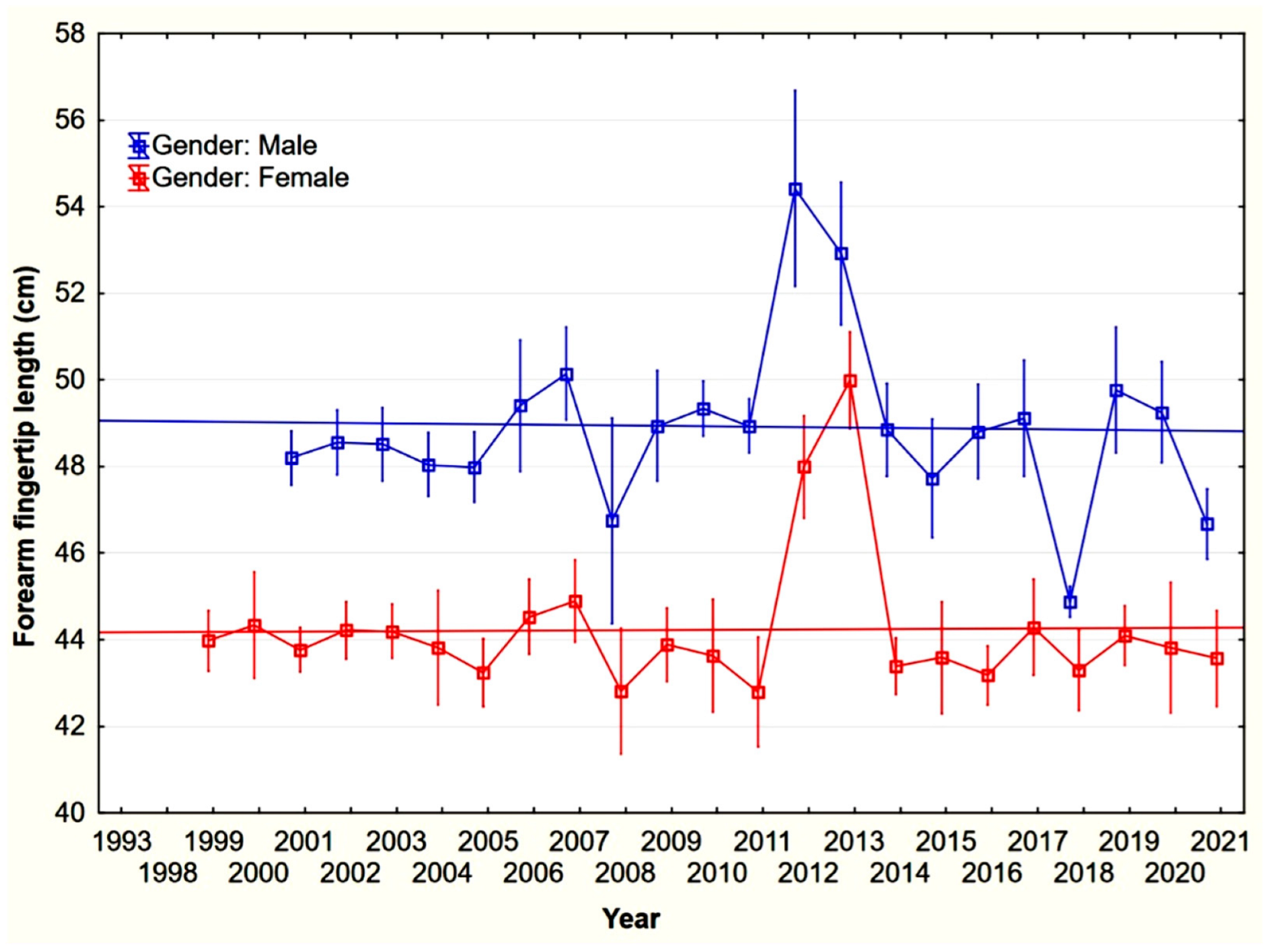
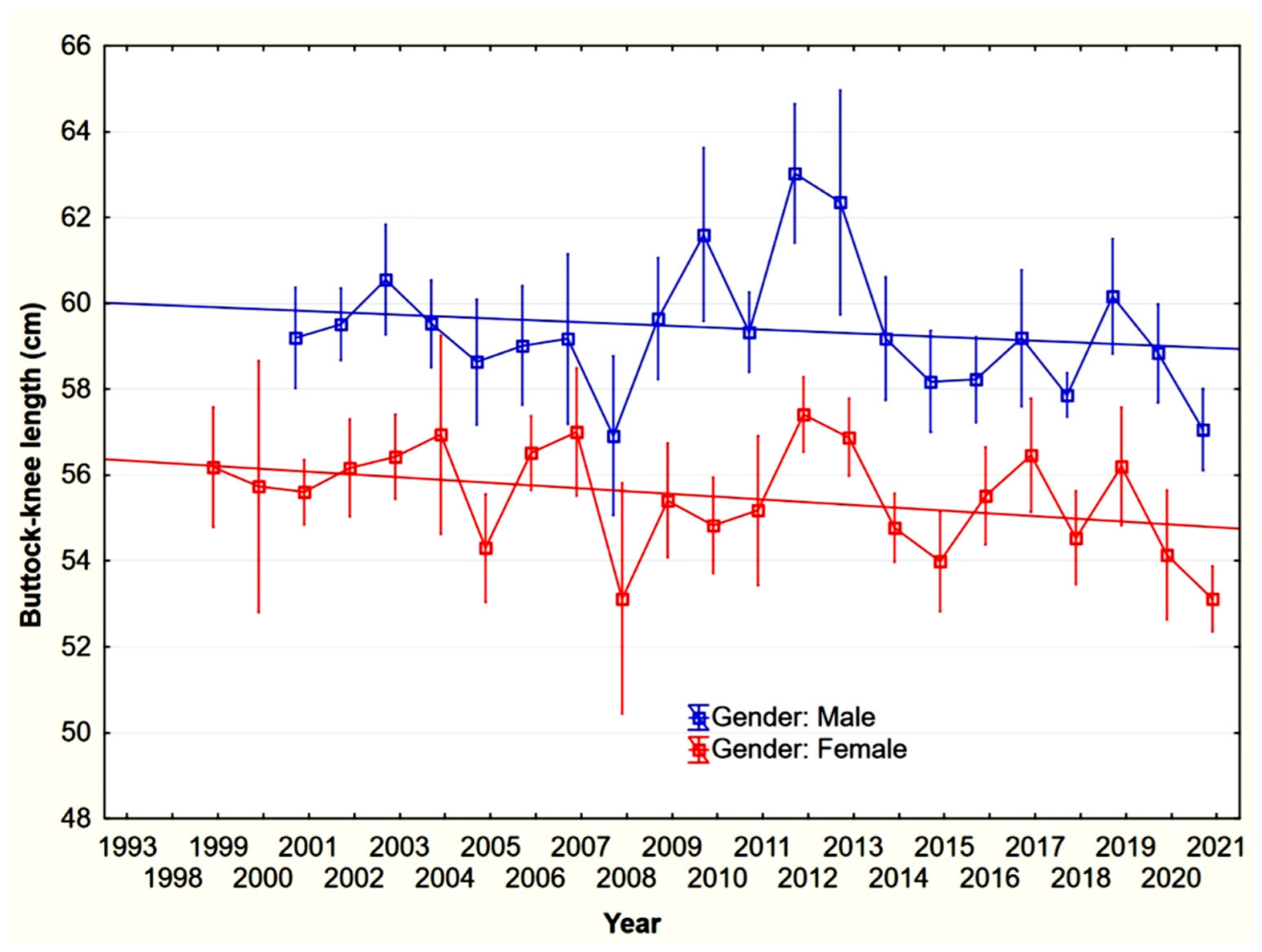
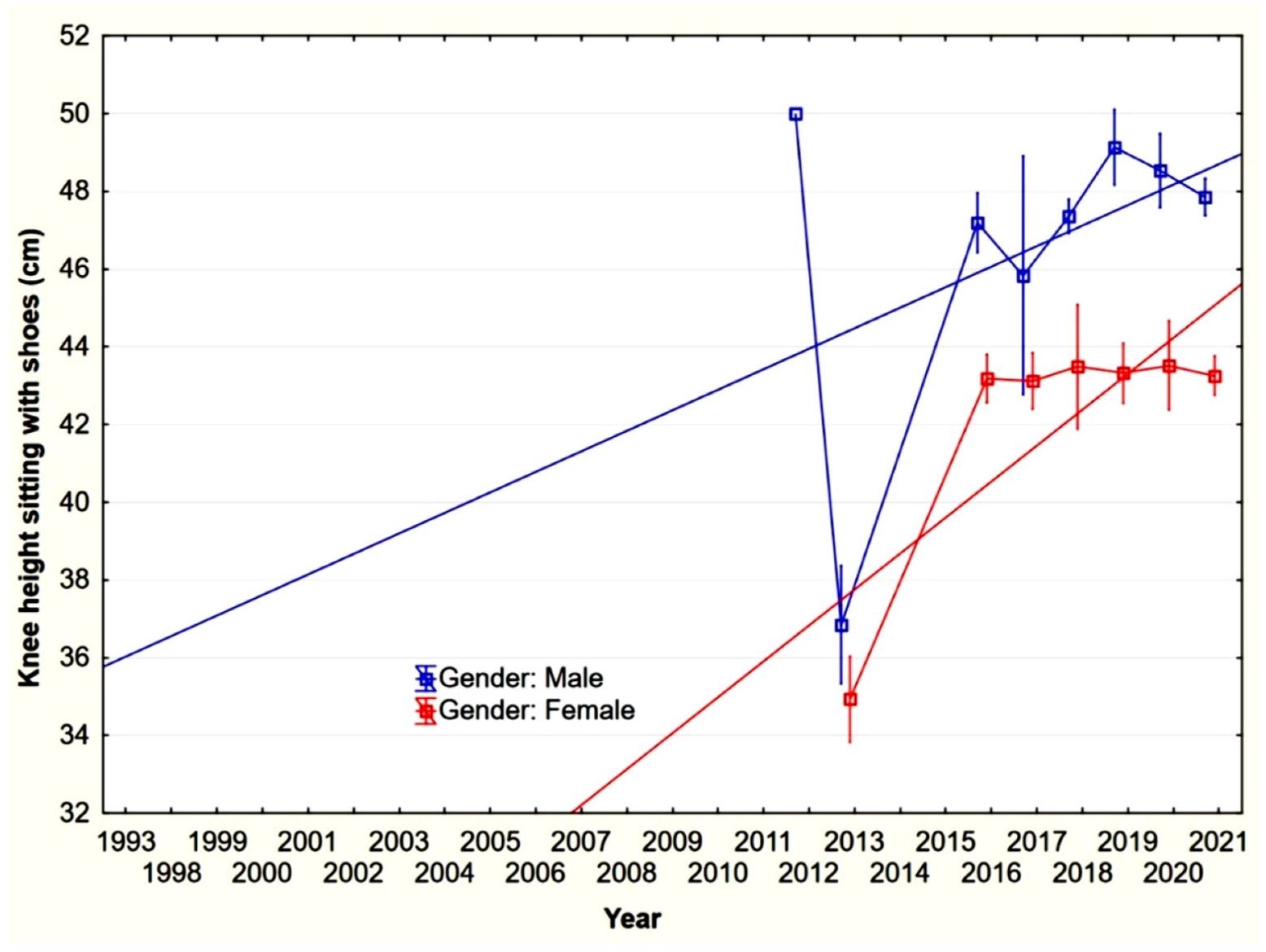
| Anthropometric Feature | Arithmetic Mean | N-Sample | Number of Men | Number of Women | Standard Deviation | Percentiles (%) | ||||
|---|---|---|---|---|---|---|---|---|---|---|
| 1 | 5 | 50 | 95 | 99 | ||||||
| Bodyweight (kg) | 7325 | 14,537 | 7355 | 7182 | 1557 | 46 | 51 | 72 | 100 | 115 |
| Height (cm) | 17,175 | 14,549 | 7352 | 7197 | 995 | 152 | 157 | 171 | 188 | 194 |
| Shoulder bi-deltoid breadth (cm) | 4547 | 8626 | 4766 | 3860 | 636 | 35 | 37 | 45 | 56 | 62 |
| Elbow height—sitting (cm) | 3693 | 3725 | 2095 | 1630 | 614 | 26 | 31 | 36 | 43 | 71 |
| Palm width (cm) | 4613 | 3628 | 2054 | 1574 | 554 | 30 | 40 | 46 | 54 | 63 |
| Hand length (cm) | 5708 | 3756 | 2109 | 1647 | 631 | 39 | 46 | 58 | 65 | 69 |
| Forearm–fingertip length (cm) | 1043 | 3723 | 2097 | 1626 | 1539 | 7 | 8 | 10 | 13 | 15 |
| Buttock–knee length (cm) | 1852 | 3715 | 2091 | 1624 | 177 | 15 | 16 | 19 | 21 | 23 |
| Knee height—sitting with shoes (cm) | 4552 | 1586 | 985 | 601 | 528 | 30 | 36 | 46 | 54 | 58 |
Publisher’s Note: MDPI stays neutral with regard to jurisdictional claims in published maps and institutional affiliations. |
© 2022 by the authors. Licensee MDPI, Basel, Switzerland. This article is an open access article distributed under the terms and conditions of the Creative Commons Attribution (CC BY) license (https://creativecommons.org/licenses/by/4.0/).
Share and Cite
Gejdoš, M.; Hitka, M. The Impact of the Secular Trend of the Slovak Population on the Production of Wooden Beds and Seating Furniture. Forests 2022, 13, 1599. https://doi.org/10.3390/f13101599
Gejdoš M, Hitka M. The Impact of the Secular Trend of the Slovak Population on the Production of Wooden Beds and Seating Furniture. Forests. 2022; 13(10):1599. https://doi.org/10.3390/f13101599
Chicago/Turabian StyleGejdoš, Miloš, and Miloš Hitka. 2022. "The Impact of the Secular Trend of the Slovak Population on the Production of Wooden Beds and Seating Furniture" Forests 13, no. 10: 1599. https://doi.org/10.3390/f13101599
APA StyleGejdoš, M., & Hitka, M. (2022). The Impact of the Secular Trend of the Slovak Population on the Production of Wooden Beds and Seating Furniture. Forests, 13(10), 1599. https://doi.org/10.3390/f13101599







